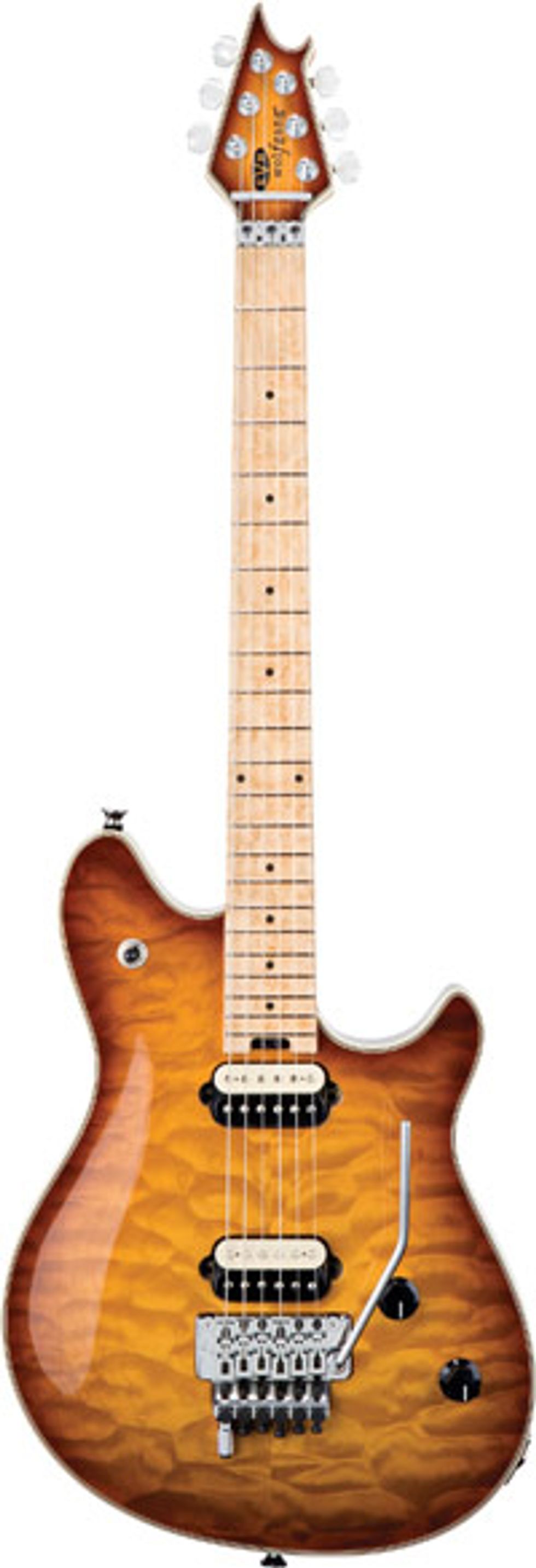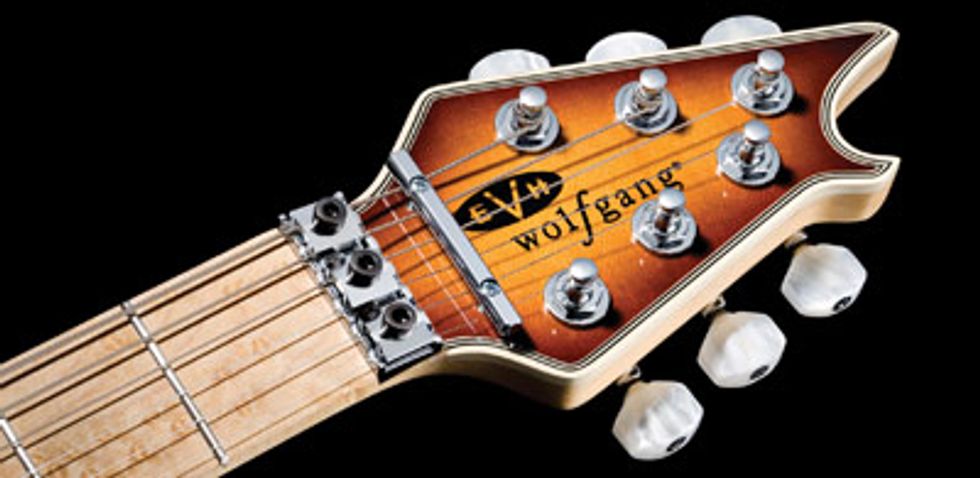 | |
| Download Example 1 Clip 1 demonstrates the perfection of the EVH D-Tuna on the EVH Wolfgang guitar. Begins with the opening riff of Dokken's "Kiss Of Death" which is in E. The second riff you hear (after the clicking noise of the D-Tuna being engaged buy pulling it out of the rear end of the Floyd Rose tremolo) is the opening riff to RATT's "Lay It Down, " which is tuned to a drop D with the key of the song in D. You can hear the tuning of the low E string is dead on without any tuning adjustments needed. | |
| Download Example 2 The clip starts with the volume all the way up, then rolled off a bit, then cranked again. | |
| Download Example 3 This clip adds a Cusack Screamer overdrive (with minimal gain and the level at 5) and an Akai Headrush delay (set to tape echo). Here, we test how the EVH Wolfgang guitar can withstand total shredfest! With the stock set-up as per Eddie's spec using Eddie's preferred string gauge (009.-.046), it took a little getting used to before hitting the record button. The thin stainless steel frets were slippery enough to allow for effortless vibrato and the low action made the tapping sequence simpler than I had anticipated. The mid section also has the Floyd Rose used in aiding vibrato to bent notes and the end has me crashing the Floyd into a divebomb with open harmonics and fretting a G on the low E string. | |
| Recorded with EVH Wolfgang guitar played through a '73 Marshall 100-watt head through a Marshall 4x12 loaded with four 25-watt Celestions and an Electro Harmonix Holy Grail reverb pedal. There is minimal gain as the amp is set at 10 (a la EVH himself). | |
The Wolfgang guitar used for this review features a basswood body and AA top with subtle figuring that glows through its amber-colored tobacco finish. The shape of the body is reminiscent of previous Van Halen signature models, but has more refined and subtle differences. Its total thickness is 1-1/2”. The maple top is arched, and is 1/2” thick at the apex of the arch. The back of the guitar is finished in a dark, transparent brown color to complement the front. A regal touch is added by a five-ply black-and-cream colored binding that surrounds the face of the body. From both sides of the neck pocket, it’s plain to see the binding is not simply trimmed off, as it rounds into the crease of the neck. The body as a whole is covered in a very thin acrylic finish.
The scale length of this guitar is 25.5”. The neck is made of a two-piece, AA heavy birdseye maple with an angled headstock. It seems bulky yet comfortable at 3/4” thick. Embedded inside it are two graphite reinforcement rods that aid the truss rod staying true. The fretboard is a separate 1/4” slab of heavy birdseye maple. The headstock also evolved from a previous EVH signature design, but has a more pronounced fork at the tip. It uniformly matches the body with the same amber-colored tobacco sunburst and five-ply binding. The frets are vintage-style, Strat-sized stainless steel wire and are rounded on the surface, not crowned to a near point. The 3-on-a-side tuners are custom-made for the Wolfgang by Gotoh, and they add to the elegance of this guitar with their pearloid buttons. The neck joins the body at the 16th fret and is bolted to the body with four offset position bolts. The heel area of the body is carved to fit the inner palm of the hand while fretting notes in the upper register of the neck. The truss rod adjustment access is at the end of the neck, recessed into an exposed cavity. It’s a wheel turned by exposed holes that needs only an Allen wrench or any metal rod (like a small screwdriver) to turn.
Getting into the Nuts and Bolts
Much of the hardware and electronics is exclusive to this guitar. The first-ever signature Floyd Rose tremolo bridge is on this guitar. It bears both the Floyd Rose and EVH brand logos. While the previous Van Halen signature guitars had licensed Floyd Rose variations, this is a specific tremolo made for this guitar by Floyd Rose. An EVH D-Tuna is attached to the low E saddle. The nut width of this guitar is 1-5/8”, and the locking nut is bolted through the back of the headstock, the more traditional Floyd Rose way. The 500k volume pot and 250k tone pot are custom-made by Bourns and EVH, and bear the EVH brand logo. They are firmly mounted to the interior of the heavily shielded electronics cavity, with grounds attached to metal screws embedded into the wood.
Unlike the non-descript knobs adorning many guitars, the Bourns pots are capped by MXR-like knobs in a nod to Van Halen’s preference for MXR pedals. The three-position pickup selector toggle switch is at the top horn of the body and is wired backwards in comparison to most guitars featuring this switch: up is the bridge pickup, middle is both pickups, and down is the neck pickup.
At the heart of this guitar are the custom-designed, custom-wound, double-potted pickups. These zebra-coiled EVH humbuckers are low output and are screwed directly into the wood. There are no springs or adjustment transit screws. The wood is carved to the exact measurement the pickups need in relation to the string height. Because of their low output, the sound of this guitar is very defined. Through a moderately overdriven amp, there is more individual string volume than the masking sizzle of a higher-output pickup.
Playability
At nearly eight pounds, the weight is average for this type of guitar. It’s set up according to Van Halen spec and factory strung with a standard .009–.042 set of strings. The neck feels more vintage and old-style with its meatier center section. Most modern rock-style guitars have necks that are thinned out in the middle, but the Wolfgang feels more like an old Strat. Like previous Van Halen-designed signature guitars, the neck shape is asymmetrical, but feels even-sided along its length. The action is very low at 1/16”—at times, it feels like the lower strings are slapping against the frets when playing fretted chords. Because it has a compound radius of 12” to 16”, the surface of the neck gets flatter as you ascend up the fretboard, easing playing in the upper register and soloing past the 12th fret. With stainless steel frets, bending notes and lightly vibrato-ed chords seem slippery to the touch and take a little getting used to. Stainless steel frets are resistant to major wear, which was the reason for using them on this guitar, but the slippery feel makes the G-string seem flimsier than normal. One thing to note is the thinness of the frets— they’re not troublesome during shredding because of the fretboard’s flatness and the straightness of the neck (due to the graphite rods). Most shred guitars feature big frets, but this guitar doesn’t need them. With the action low and slippery frets, shredding seems effortless. Again, it takes a little getting used to, but once you get started, the temptation to perform the intro chords to a Van Halen classic like “Somebody Get Me a Doctor” is inevitable.
The Floyd Rose tremolo set up is for downward travel only. It’s seated into the wood and recessed only slightly into the body in its resting position. This contributes much to the natural string vibration transfer. When depressing the bar downward, it only takes a light touch because there are only two springs. This also contributes to making bending notes feel less stiff. The D-Tuna is a push-in/pull-out attachment that drops the low E to a perfect D.

The guitar’s natural resonance is significant— you can feel substantial vibrations in the neck, and the guitar is easy to hear unplugged. The lack of lacquer allows the naturally resonating piece of wood to vibrate freely. As a tonewood, basswood is less trebly and has a porous mass, giving this guitar its natural midrange. The maple top adds the density needed to give it the treble without adding more unneeded mass.
Plugging into a moderately overdriven amp, the tone is ripping. Unlike some guitars that have moderate output pickups, the low-output EVH humbuckers have a string clarity in which you can hear every string in barre chords. For most of the testing, the bridge pickup was used (since it’s used 90 percent of the time in hard rock settings). There seems to be more natural string volume, making it sound much more aggressive than some metal guitars with active pickups. Rolling down the volume knob, the tone is clean, and open chords ring with clarity. The vibration transfer to the pickups is due mostly to the fact that they’re screwed directly to the wood. This is the reward for such a painstaking measurement and routing job—the pickups are just deep enough to be in perfect relation to string height. This in itself is ingenious in the design of this guitar.
Speaking of rolling the volume knob, the Bourns 500k volume pot has a low-friction action to its rotation. The taper is gradual and not sudden when bringing it up or down. This is more evident from the zero point and glides easily without much force.
Another contributing factor to the guitar’s tone is that the Floyd is non-floating, as the bridge plate rests on the surface of the body. What this does is lessen the amount of vibration lost, as happens when a Floyd Rose is suspended only by the pivot posts. This sucker sits squarely on the body and makes the guitar sustain well when striking a simple A chord, or holding a single note for quite a while.
The Final Mojo
The new EVH Wolfgang is a guitar made from years of Eddie Van Halen’s own research. It has an ease of playability and though somewhat small-bodied, it sounds like a herd of wild elephants when cranked through an overdriven amp. The outstanding features of the guitar are the stainless steel frets, the thinly coated body, low-output pickups screwed into the wood, and the non-floating Floyd Rose seated into the body. After putting this guitar through the ringer, abusing the volume knob, dive bombing the Floyd and trying to outplay the fretboard for several hours, this guitar kept coming back—no need to retune it, or even consider adjusting the polepieces in the bridge pickup. Checking the fretboard for a hair of wear on the frets turned up no single indent. While this guitar might not be for everybody, it truly lives up to its design claims. If this is truly meant to distribute to a wider guitar-playing audience exactly what Eddie uses, this guitar serves as testament to him. Plain:
Buy if...
You want defined clarity from low-output pickups in a guitar that’s built like a tank, with consistent action and wear-resistant frets.
Skip if...
You’re a rock player who enjoys standard production guitars with high-output pickups to mask your tone.
Rating...
MSRP $3149.99 as reviewed - EVH Brand Guitars - evhgear.com |













![Rig Rundown: Russian Circles’ Mike Sullivan [2025]](https://www.premierguitar.com/media-library/youtube.jpg?id=62303631&width=1245&height=700&quality=70&coordinates=0%2C0%2C0%2C0)

















